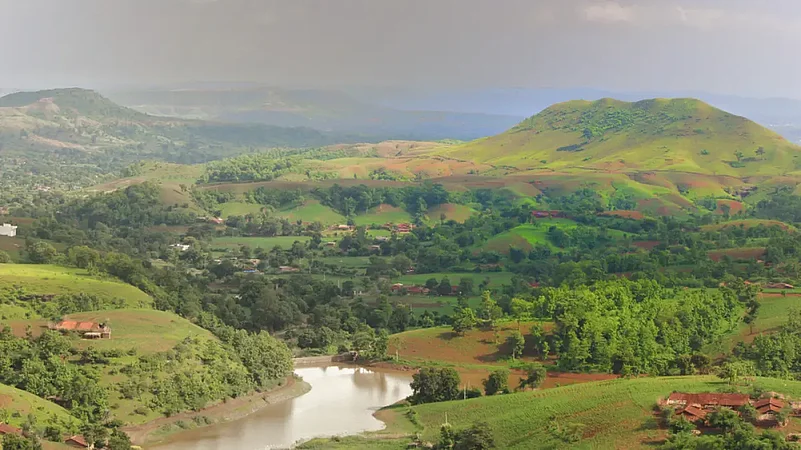A polished emerald, largely undiscovered by the great throngs of travellers who hit the popular tourist trails of Rajasthan, Banswara—‘City of a Hundred Islands’ opens up fabulous experiences in the verdant monsoon season. Evergreen all year round and with lakes and waterfalls aplenty the region, Banswara is just three hours away by road from Udaipur, that flamboyant city with its fairy-tale palaces and tranquil lakes. On your way stop by at the local tea stall, known as Kewada Ki Naal, and refresh yourself with the unique tea brew made from locally grown herbs, like lemongrass.
Located between Udaipur and Chittorgarh, the area around Banswara has long been the home of the Bhil tribesmen. History reveals that Banswara was ruled by a Bhil ruler named Bansia (Wasna), who was defeated by Jagmal Singh who then went on to crown himself Banswara’s first Maharaval. Two high points of Banswara’s lush natural beauty were the abundance of its bamboo groves and the numerous water bodies. And though the bamboo has been sacrificed in the run for developing the town, you can still enjoy exploring the lakes and pretty islands set amidst its backwaters.
Lake Story
Drained by the Mahi River, Banswara has capitalised on the damming of the waters by the Mahi Dam, more so when in the rainy season the sluice gates of the dam are opened and the water comes boiling out in its hurry to sweep through the verdant landscape. Picnickers at the massive waterbody of the dam site make merry while revelling over this great bounty. This is the biggest water reservoir in the Udaipur division. Embroidering the fringes of Kagdi Lake, the Kagdi Pick Up Garden is a lovely green lung which attracts a bounty of avifauna. With its fountains and pathways winding through the landscaped expanses it’s also a huge draw for avid birders and nature lovers. Boating on the lake offers excellent photops from another perspective.

Anand Sagar Lake, also referred to as the Bai Talab, was commissioned by Lanchi Bai, the Rani of Maharaval Jagmal Singh. It is popular for the ‘Kalpa Vriksha’ trees found in great numbers here. This sacred tree is believed to have wish-fulfilling powers. There are a few cenotaphs scattered around this verdant space. Raj Mandir, or the City Palace, from its hilltop perch yields splendid views of Banswara and its verdant surrounds. Dating back to the 16th century, it is built along the elegant lines of traditional Rajput palace architecture. The summer retreat, Badal Mahal, is located on the shoreline of Diablab Lake, a lotus-filled tranquil water body.
Waterfalls and Monsoon Magic
Banswara has long been loved by the local people for its picturesque waterfalls, perfect for leisurely picnics. Many of these come into their full glory during a good monsoon. Singpura Fall which drops from a height of 150 ft is also locally known as Wagad Ka Niagara. Jholla Falls in Naugama village, is around 30 km from Banswara city. What adds to its beauty is the lush verdure of its setting. Jua Falls is powered by an exuberant monsoon. Scores of revellers cut through the forested trails to enjoy the thunder and glory of this sparkling outburst of nature. Kadeliya Fall offers lots of fun to local picnickers who can enjoy the shallow pool created by the falls.
But in the monsoon it is inadvisable to take a dip as the current becomes quite strong. Jagmeru Hill Station, located just 12km from Banswara becomes a bower of verdant splendour in the monsoons.
A steep road leads to the Hanuman temple which attracts many devotees. Samai Mata – Bhandariya (4km) Nestled in the verdant hills around Banswara, the Samai Mata Mandir is also a popular picnic spot for locals. The temple itself is accessed by about 400 steps.
Chacha Kota Backwater
The hinterland of the dam, some 14km away from Banswara, is studded with hundreds of richly forested little islands (originally small hillocks which got submerged in the dam waters) spread across the Chacha Kota backwaters; the low hills are alive with the sound of dozens of small silvery waterfalls streaking down the forested hillsides. The uncrowded spaces by these hillsides here are studded with tiny settlements where your attention is grabbed by this pastoral serenity. Roosters crow stridently calling to their harem and cows moo as you stop for a chat with the friendly local Bhils. Livestock rearing and growing crops like maize, wheat, rice, soya bean etc on their small holdings are major source of livelihood.
Surprisingly, Banswara is also popular for the varieties of mangoes grown here– including the 18 indigenous varieties. So in the monsoons you can also indulge your mango mania here. The forested hills of this tribal belt are filled with birdsong are rich in expensive timbers like teak and mahua and offer leopard-spotting and avifaunal adventures.


























